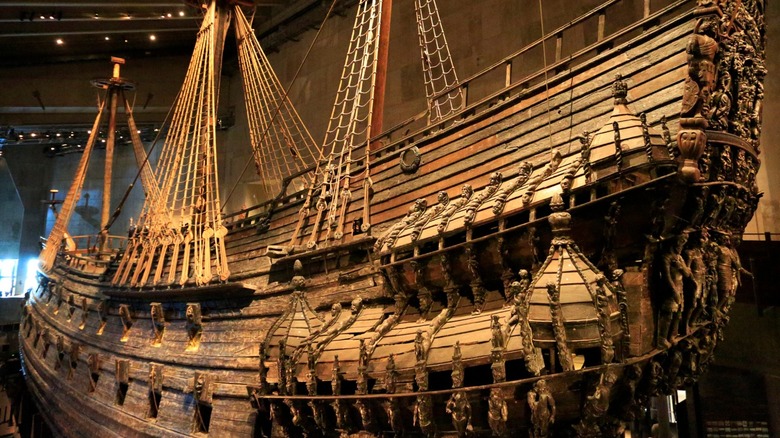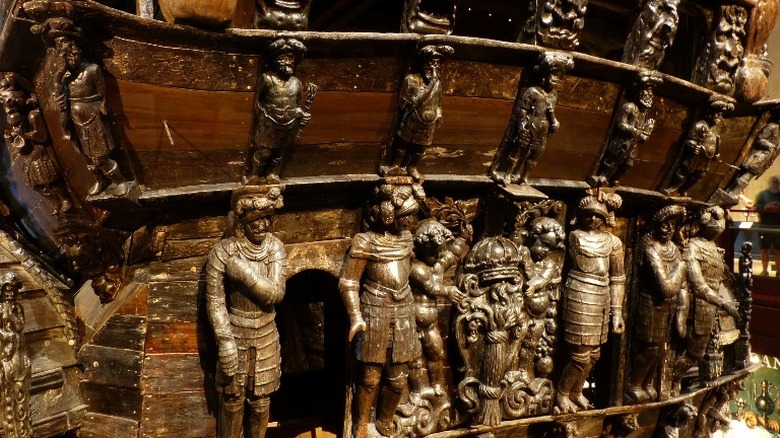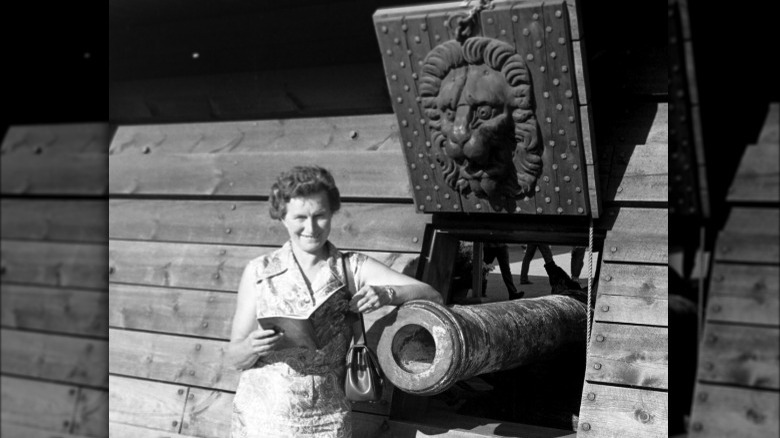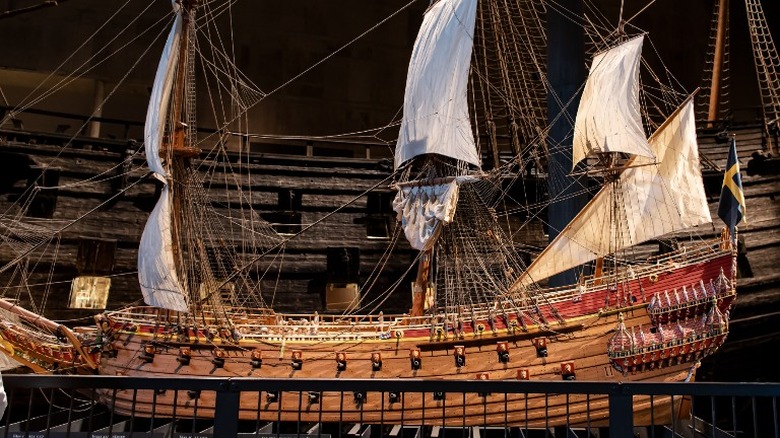The True Story Of Sweden's Prized Vasa Warship That Sunk Before Even Leaving The Harbor
When it comes to the legends of the high seas, the tales of epic ships are prominent throughout history. Some of the best-known vessels to ever sail the ocean include RMS Carpathia, The Mary Rose, RMS Luisitania, and of course the RMS Titanic. All of these ships have one thing in common: At some point in their journeys, they sank and now rest in the ocean depths.
While sailing the seas is always a daunting endeavor, humans have done it for thousands of years. From the ancient Phoenicians to the cruise ships of today, oceangoing vessels have changed over time. Some of history's greatest shipbuilders were the Vikings, who set sail from their home in Scandinavia to conquer the world during the Viking age (per History Hit). Their descendants who now inhabit the country of Sweden continued the boat-building tradition, even centuries down the line. One of their most famous, though ill-fated, constructions was the Vasa warship.
Who built it, and why?
According to All That's Interesting, Sweden became a predominant European empire during the 17th century, when it emerged as the ruling power in the Baltic region. The Swedish King Gustav II Adolph (above) was successful in leading his country through many wars, which was good, because for 18 out of the 21 years that he ruled, his country was at war (per Vasa Museet). Despite constantly engaging in conflict, Sweden continued to grow in its power, and the foundations of bureaucracy in the country were laid.
Though largely successful in his reign, King Gustav was caught up in another conflict that was not so easily remedied. There was a large controversy over his claim to the throne, as it was being challenged by his cousin, Sigismund, who had been deposed. In order to secure his interests in the region of Poland-Lithuania (which his cousin ruled), Gustav needed to have a large and strong navy. After suffering some initial damage to his naval forces, Gustav made an attempt to overhaul his navy, and his first endeavor was the Vasa.
An engineering marvel
The commission of this particular battleship was very different from anything that had been seen in Sweden's naval history before. Legendary shipmaster Henrik Hybertsson took inspiration from King Gustav II Adolph's lineage as a part of the Vasa dynasty (per All That's Interesting). At the navy yard in Stockholm, construction on this new warship as well as three additional vessels began in January of 1625. The goal was to create the most powerful warship in the Baltic, and eventually the world (per Vasa Museet).
This navy yard became a very busy place once these new ships were commissioned. Supplies were brought in from all across the country and across Europe as well. The timber was native to Sweden, hemp was brought in from Latvia, tar was transported from Finland, sailcloth was shipped from France and Holland, while coal came from England. In the warmer parts of the year, upwards of 400 people were working to build these ships, natives and immigrants alike. These workers were hustling around the clock to construct a boat that would lead the Baltic's strongest navy.
Finished Product
When the Vasa was finished, it was reportedly a sight to behold. The vessel was over 226 feet long, and was adorned with detailed carvings that paid homage to the king and his family line (per All That's Interesting). Though there were other ships that were physically larger, the Vasa compensated for that with the amount of weaponry that it carried.
According to Ancient Origins, the ship weighed a staggering 1,200 tons, contained 120 tons of ballast, and boasted 10 sails while being 164 feet high at its tallest point. Additionally, the Vasa was saddled with a grand total of 64 cannons, meant to strike fear in the hearts of those who dared challenge the Swedish navy. Decorated in spectacular fashion and loaded with weapons to the hilt, this warship was boasted as one of the greatest engineering feats of the day. Unfortunately, the vessel would never even make it out of the harbor.
Catastrophic failure
On August 10, 1628, the Vasa was to set sail on her maiden voyage from Stockholm to a fortress called Voxholm (via All That's Interesting). The ship was then to rendezvous with the rest of the summer fleet, where it was supposed to become the lead ship of the reserve squadron. Unfortunately, things went horribly awry within 20 minutes of departure, when the mighty Vasa began to sink after being hit by a strong gust of wind. The ports for the cannons were open, and when the wind caused the unstable ship to tilt too far to the side, water rushed in. The Vasa headed to the ocean floor.
The fact that this ship sank so easily shows that something had gone very wrong. Most of the failures that caused the boat to sink were related to its construction. The Vasa was shockingly unstable in multiple ways. Numerous changes had been made to the design during the construction process and they turned out to be catastrophic. The biggest change was increasing the size of the vessel. The second biggest problem was the weight that was put on the ship with the decorations and weaponry.
After the sinking, an investigation was launched. It was later revealed that when weight shifted across the deck, the ship would roll alarmingly in either direction. Despite this being a proven flaw before the ship launch, the navy's admiral kept his mouth shut about it, and the voyage went ahead anyway. The sinking of the Vasa resulted in the deaths of 30 crew members as it sank to the bottom of the harbor.
Raised from the depths
Despite arguably being one of the greatest failures in naval warship history, the Vasa is one of the world's most famous ships. The cold water of the Baltic Sea is great for preservation, and so later generations have been able to study the wreck. In 1961, Sweden raised the warship from its watery grave (per Smithsonian). Incredibly, 95% of the ship's structure was still intact.
Extracting the Vasa and keeping it intact was an incredible feat in itself, but it was done successfully. After three centuries on the ocean floor, the vessel was able to be preserved, following another three decades of work. Though we know a couple of reasons that may have contributed to the vessel's demise, archaeologists are still studying it today to discover all of its secrets, including its flaws. The Vasa now rests in the Vasa Museum, where visitors from all over the world can see the massive warship up close.





